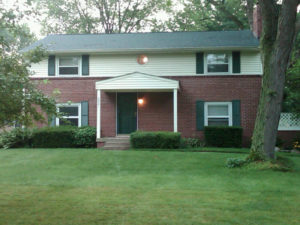This is the final (for now any way) post in a loose series about the important of place, location and work environment and how it connects with our values, and ultimately how the intersection of these things relates to productivity. If you missed any of the others, or to provide a context for these thoughts, here are the other posts:
Five Practical Reasons Values Matter to Leaders
Four Ways Location Influences Results
This post is about our offices here at The Kevin Eikenberry Group. There isn’t a cubicle in sight. We have thee bathrooms, a full kitchen, a couch and two fireplaces. We have a gazebo, a two car garage and many other things you might not associate with an office. Our offices are in a 51 year old brick home on the suburban north side of Indianapolis.
Why did I purchase a house rather than leasing office space, or buying a small office building?
My answer relates to all of the posts listed above. Let me explain.
I wanted to create an environment that allowed people to be creative, comfortable and that would create community. I wanted to have a place others would be drawn to. I wanted to create something people liked and wanted to be a part of.
The work that we do is creative by nature – working with clients to develop more effective leaders, expand organizational results and promote greater productivity and creativity. Developing products, training and other tools to do the same and writing for a wide variety of purposes. Given that, it was important to make the space conducive to creativity. No we don’t have a foosball table or pinball machine, like you might find in some technology companies, but we do have a couch, and a gazebo, and a conference table that started life as a dining room table – all factors that create new physical environments and evoke thoughts – even for those of us who have worked there since we moved in – that are different than “an office.”
Growing up on a farm and being part of a family farming business, work was blended with family in what felt seamless in many ways. One example: whomever was working for us ate lunch (and often dinner) at our kitchen table, as a part of the family. I wanted to create that feeling on my team, because I felt it would create a positive dynamic and working relationships that would transcend work. While we don’t all eat lunch together, many times people do, around that dining room/conference table. I believe our selection of an creation of environment has succeeded in creating that feeling.
These are just two examples of conscious choices we made in selecting and furnishing Remarkable House with the intention of creating a work environment that allows us to do our best work, grounds us in our values and is fun.
I realize that most people reading this aren’t looking to buy an office space, and may not have the opportunity move walls, provide couches and the like. If because of that you think this post is interesting but not relevant, you’ve missed the point (or I’ve done a poor job of writing so far).
I’ve shared a personal example, designed to get you think about your working environment, whether it is your personal space or for an entire organization.
Here are some questions to extend your thinking and challenge you be more intentional and make conscious choices about the work environment you want to have/create.
How do your personal and/or organizational values inform what your physical space should include or feel like?
How closely does your actual environment match your answers to that question?
Does your work environment attract to you the type of employees and/or Customers you want?
If not, what needs to change to spur that sort of attraction?
How does your physical environment make you and others feel at work?
Does your work environment support collaboration, teamwork, fun and productivity?
What could you and/or your team do immediately (in less than a week) to improve or change your environment, based on your answers to these questions?
Those are a start.
None of these may feel like earth-shattering or urgent questions, yet thinking about and answering them can directly lead to increasing productivity, expanding job satisfaction, reducing stress (your own and others), and improving retention.
These are all reason enough to ask these questions. Spend some time (now) thinking about them. Spend some time (soon!) taking action on your answers.


You’ve inspired me to think about a co-working location in a new way. I’ve been browsing business spaces and seeing how they could be made community-like when I should be looking at houses! Thanks.
My pleasure Janet! Best of luck in your search.
Kevin 🙂
Thank you for this post Kevin. The work environment is an essential part of managing and overcoming stress reactions. You may find a few answers to your questions here http://tinyurl.com/2euyna8
You are most welcome – and thanks for the resource.
Kevin 🙂
Kevin: Thanks for a meaningful and thought provoking post. Your guidance toward viewing work space (and personal space too) differently has me thinking! Thanks!
Thanks Robin. Glad it helps!
Kevin 🙂